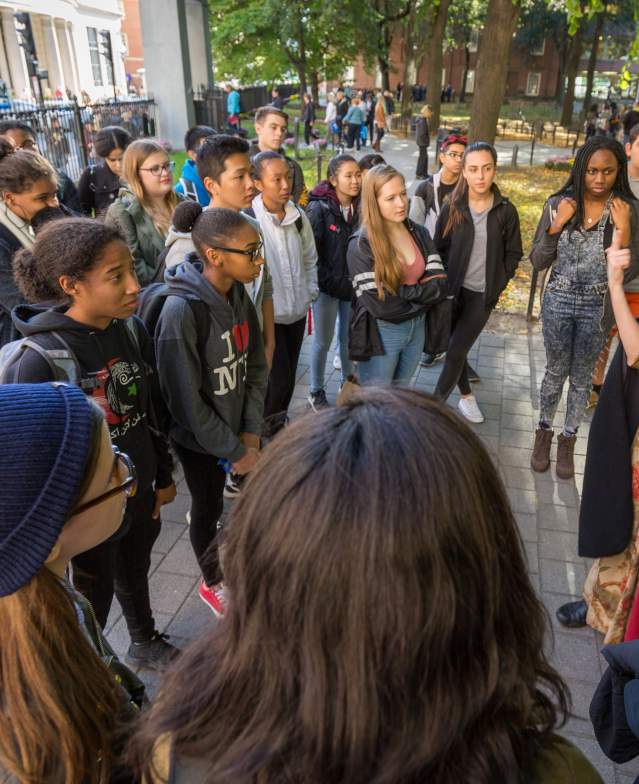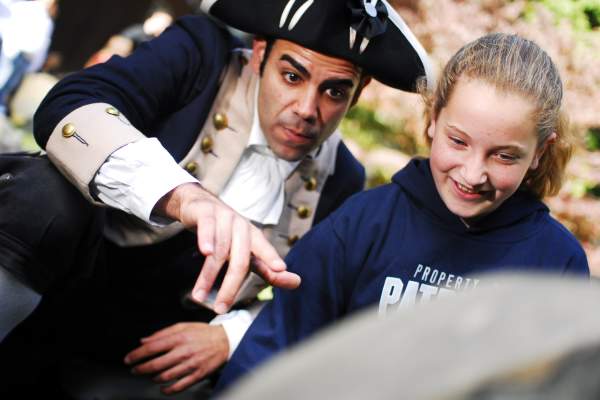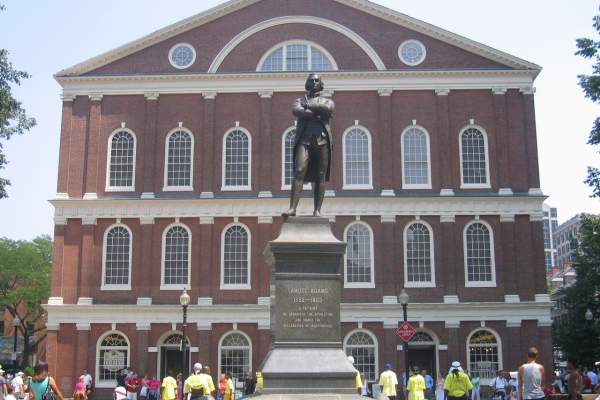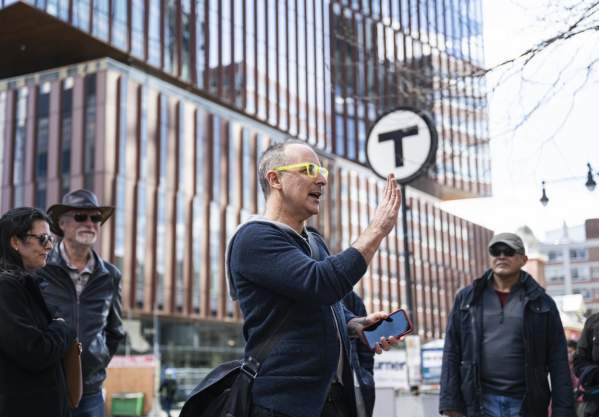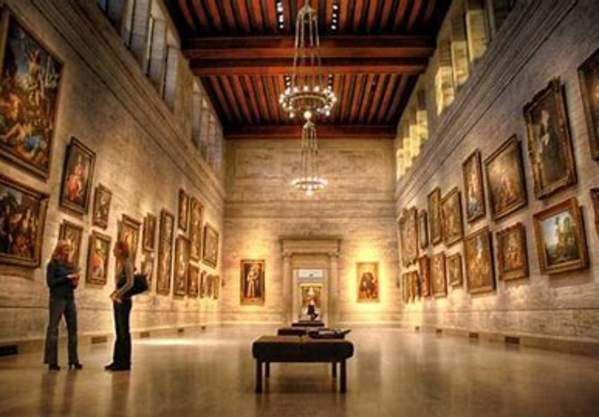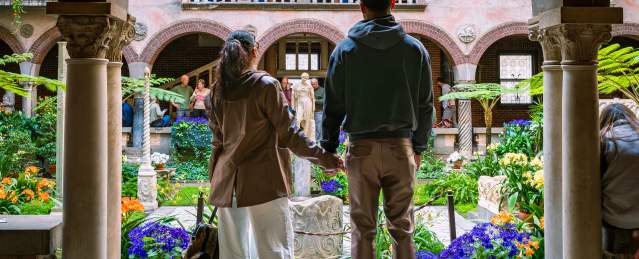The Freedom Trail®
Walk Through America’s History
The famous Freedom Trail is a 2.5-mile red-brick trail through Boston’s historic neighborhoods that tells the story of the American Revolution and beyond. From the Old North Church to Faneuil Hall, and through resonant burying grounds, visit the temples and landmarks of the Revolutionary Era.
Freedom Trail Sites | Map of the Freedom Trail | Freedom Trail Walking Tours | FAQ
Freedom Trail Sites
Begin your journey at the Boston Common Visitor Information Center located at 139 Tremont Street and conclude at the USS Constitution in Charlestown.
- BOSTON COMMON
- MASSACHUSETTS STATE HOUSE
- PARK STREET CHURCH
- GRANARY BURYING GROUND
- KING’S CHAPEL & BURYING GROUND
- BOSTON LATIN SCHOOL SITE/BENJAMIN FRANKLIN STATUE
- OLD CORNER BOOKSTORE
- OLD SOUTH MEETING HOUSE
- OLD STATE HOUSE MUSEUM
- BOSTON MASSACRE SITE
- FANEUIL HALL
- PAUL REVERE HOUSE
- OLD NORTH CHURCH
- COPP’S HILL BURYING GROUND
- USS CONSTITUTION - OLD IRONSIDES
- BUNKER HILL MONUMENT
BOSTON COMMON
Back to Top of ListThe Boston Common is America’s oldest public park, purchased from Wm. Blackstone in 1635 to be used as common grazing land for the feeding of cattell. The British militia used it as a trayning field.
The Common has also been the site of hangings, duels, public celebrations and spirited oratory. Today it continues to host public celebrations as well as concerts, ice skating, Shakespearean plays, holiday festivities, sports activities and public rallies.
MASSACHUSETTS STATE HOUSE
Back to Top of ListDesigned by Charles Bulfinch, the State House was completed in January 1798 at a cost of $133,333 (more than five times the budget). John Hancock, a wealthy merchant, patriot, signer of the Declaration of Independence and the first elected Governor of Massachusetts originally owned the land. The oldest building on Beacon Hill is now the seat of the Massachusetts state government. The golden dome, one of Boston’s distinguishing landmarks, wasn’t always gilded. It was originally built of wood. Paul Revere & Sons was commissioned in 1802 to cover it with copper to prevent water leakage. In 1874, the dome was gilded with 23-karat gold leaf.
PARK STREET CHURCH
Back to Top of ListPark Street Church acquired the nickname Brimstone Corner, both in reference to the fire-and-brimstone sermons and to the gun powder that was stored in the crypt during the War of 1812. Founded in 1809, the Church’s 217-foot white steeple was the first landmark a traveler saw upon approaching Boston.
On July 4, 1829, abolitionist William Lloyd Garrison gave his first public anti-slavery address here, and two years later, on July 4, the hymn America, better known as My Country ’Tis of Thee, was first sung on the Church steps.
GRANARY BURYING GROUND
Back to Top of ListSo named because of its proximity to Boston’s first granary, this is the most visited burying ground in Boston and the final resting place of many prominent Bostonians. Buried here are John Hancock, Samuel Adams, nine governors, all five Boston Massacre victims, Paul Revere, Ben Franklin’s parents and Peter Faneuil.
KING’S CHAPEL & BURYING GROUND
Back to Top of ListUnder orders from King James II in 1686, land was seized, and the first Anglican Church was constructed. By 1749, the original wooden structure was too small for the congregation, and so the Georgian chapel was constructed around the original church.
Adjacent to King’s Chapel is Boston’s first burying ground. Here you will find the graves of John Winthrop, Massachusetts’ first governor; William Dawes, Paul Revere’s compatriot who also made the ride to Lexington, and Mary Chilton, believed to be the first woman to step off the Mayflower.
BOSTON LATIN SCHOOL SITE/BENJAMIN FRANKLIN STATUE
Back to Top of ListEmbedded in the sidewalk in front of Old City Hall is the mosaic City Carpet, which commemorates the site of the first public school in the U.S., Boston Latin School (1635). Among the school’s alumni are Ben Franklin, John Hancock, Samuel Adams, Charles Bulfinch and Ralph Waldo Emerson.
Richard Greenough’s statue of Ben Franklin, erected in 1856, prominently stands in front of Old City Hall. Look closely at Franklin’s face. The sculptor said that he found the left side of the great man’s face philosophical and reflective and the right side funny and smiling.
OLD CORNER BOOKSTORE
Back to Top of ListThe original building on this site was the home of Anne Hutchinson, who was banished from Massachusetts in 1638 for her unorthodox religious views. By the mid-1800s, the Old Corner Bookstore was a flourishing literary center. Here, Ticknor and Fields published works by Dickens, Harriet Beecher Stowe, Tennyson, Hawthorne, Emerson, Longfellow, Oliver Wendell Holmes, Elizabeth Barrett Browning and Julia Ward Howe among others. The Atlantic Monthly, a Boston institution, was originally published here as well. Today, the building continues as a place of commerce.
OLD SOUTH MEETING HOUSE
Back to Top of ListBuilt in 1729, this is the second oldest church in Boston. The largest building in colonial Boston, Old South was used for public meetings when the angry crowd outgrew Faneuil Hall. Many of the crucial events that led up to the Revolution took place here. The most famous of the meetings was held on December 16, 1773, when over 5,000 gathered to protest the tax on tea.
During the British occupation of Boston in 1775-1776, British troops desecrated this sanctuary of freedom by using it as a stable and riding school, while drinks were served from the balcony. The pulpit and pews were chopped into firewood and the library was used as kindling.
On another note, Phillis Wheatley, the first female African American published poet, was a full member of the Meeting House. An original copy of her work is on permanent display here.
OLD STATE HOUSE MUSEUM
Back to Top of ListBuilt in 1713, the Old State House is Boston’s oldest surviving public building. It was the center of political and commercial life, housing the merchant’s exchange (a precursor to today’s stock exchange) on the ground floor and the royally appointed government offices and the freely elected members of the Assembly of the Massachusetts Bay Colony on the upper floors.
The site played a central role in the story of rebellion, from James Otis’ 1761 speech against the Writs of Assistance to the Boston Massacre in 1770 to the reading of the Declaration of Independence from the east balcony in July 1776.
BOSTON MASSACRE SITE
Back to Top of ListAdjacent to the Old State House, a ring of cobblestones commemorates the Boston Massacre. Five men were killed in this clash between Colonists and Redcoats. Among the slain men was Crispus Attucks, the first African American to die for the patriotic cause.
Interestingly, John Adams and Josiah Quincy, loyal to justice as well as the patriotic cause, defended the British soldiers. All but two were acquitted. The guilty had their thumbs branded and were then set free.
FANEUIL HALL
Back to Top of ListThe building was a gift from wealthy merchant Peter Faneuil in 1742. Faneuil Hall served as a meeting place and an open-air market. It was here that Bostonians met to form their opposition to British authority. As a result of the impassioned speeches by such patriots as Samuel Adams and James Otis, the nickname Cradle of Liberty was earned, especially when citizens rallied against the Sugar Act, the Stamp Act, the Townsend Acts and the landing of British troops.
Charles Bulfinch enlarged the building in 1806. After the Revolution, Bostonians continued to gather at Faneuil Hall for the anti-slavery speeches of William Lloyd Garrison, Wendell Phillips and Frederick Douglass. The women’s rights movement, early temperance rallies and nearly every war since 1812 have been debated within these walls.
PAUL REVERE HOUSE
Back to Top of ListBuilt around 1680, the Paul Revere House is the oldest remaining structure in downtown Boston, and only official Freedom Trail site that is a home. It was from here that its famous occupant set out for the midnight ride. Revere was not only a patriot, but also an expert silversmith, copper manufacturer, part-time dentist, engraver and the father of 16 children. As many as eight children lived here with him, along with his mother, his first and (after 1773) his second wife.
OLD NORTH CHURCH
Back to Top of ListIt was from this steeple that Sexton Robert Newman hung two lanterns on April 18, 1775, to signal the beginning of Paul Revere’s momentous ride. The action is widely regarded as the spark that ignited the American Revolution.
Built in 1723, Old North is Boston’s oldest church building. See a wealth of historic works, including the first bells brought to the Colonies, its original 18th-century brass chandeliers and clock, and the 17th- century carved angels that were captured by a Colonial privateer. More than 1,000 individuals lay in rest in the underground crypt, including the Royal Governor’s second-in-command at Lexington and Concord.
COPP’S HILL BURYING GROUND
Back to Top of ListCopp’s Hill was Boston’s largest colonial burying ground, dating from 1659. Some notables buried here include the Mather family, a very prominent New England ministerial family; Edmund Hartt, builder of the USS Constitution; Robert Newman, who hung the lanterns for Paul Revere’s ride, and Prince Hall, anti-slavery activist, Revolutionary soldier and founder of the African Grande Masonic Lodge. Copp’s Hill is also the final resting place of countless free African Americans.
Because of its height and prominent location overlooking Boston Harbor, the British used the burying ground to aim their cannons on Charlestown during the Battle of Bunker Hill. Target practice was also conducted here. Be sure to take a look at the grave marker of Daniel Malcom, a member of the Sons of Liberty.
USS CONSTITUTION - OLD IRONSIDES
Back to Top of ListLaunched in Boston in 1797, the USS Constitution is the oldest commissioned warship afloat in the world. Her nickname was earned during the War of 1812 when British cannonballs appeared to bounce off her impenetrable hull and the seamen cried out Huzzah! Her sides are made of iron! Today she is manned by an active duty U.S. Navy crew and docked in the Charlestown Navy Yard.
BUNKER HILL MONUMENT
Back to Top of ListThe Battle of Bunker Hill was one of the bloodiest battles of the American Revolution. "Don’t fire until you see the whites of their eyes!" became the legendary battle cry, according to lore, and immortalized the determination of the ill-equipped Colonists who stood facing the powerful British Army on June 17, 1775. Today the 221-foot granite obelisk commemorates the site of this first major battle.
Freedom Trail Walking Tour Operators
Stop by a Visitor Information Center to purchase a ticket. Tours leave from the red brick line in front of the Boston Common Visitor Center.
- (617) 357-8300
Boston's official Freedom Trail® tours take you to places where history was made! Walk Into History® along the iconic Freedom Trail – the 2.5-mile red line leading to 16 nationally significant historic sites, each one an authentic treasure – with the Freedom Trail…
- 87 Mount Vernon Street
- (617) 367-2345
Boston By Foot offers a wide range of in depth historical and architectural walking tours on special topics and neighborhoods throughout the city. Our tours are offered regularly April through November, and can be arranged as a private tour at any time of the year. You can select…
- (617) 794-7512
Best Freedom Trail walking tour! Our guided tours last 90-minutes. Our tour guides wear historically accurate period dress and explain the significance of 11 historic sites in the richest, most densely historic part of Boston.Highlights include an old, historic graveyard where…
- 7 Marshall Street
- +1 (844) 482-8696
The world-famous Freedom Trail is best experienced on foot, in a small group, with a knowledgeable local guide! Your 2.5-hour tour travels from Boston Common to Copp's Hill Terrace in the North End, providing guests a chance to see ALL SIXTEEN official landmarks on the Freedom…
- 92-510 Akaula Street
- (808) 201-8138
Explore with Shaka Guide: Your go-to for immersive audio tours. Uncover destinations like never before with an expert audio tour guide. Boston Tours include: Freedom Trail Part 1 & Part 2 Beacon Hill Walking Tour
- Boston Common Visitor Center
- (978) 741-1170
Tour of the Freedom Trail by The Histrionic Academy offers walking tours of Boston and the freedom trail using costumed historical interpreters as guides. These historians/tour guides are available for both public and private events. We can also be seen performing at historical…
Freedom Trail Self-Guided App
- Citywide
- (508) 506-1844
Boston Freedom Trail & Bunker Hill GPS self-guided audio tours: Experience the rich history of Boston and its role in the American Revolution with the Freedom Trail & Bunker Hill Walking Tours bundle. Explore the 16 official sites of the Freedom Trail, such as Boston Common, Old…
- 1 Kendall Sqr.
- (628) 688-7961
Tailbox delivers AI-driven, self-guided tours tailored to your passions and location. Find things to do, discover insider stories, cities, museums, and hidden gems in real time, right where you are.
- 450 Harrison Avenue, #208
- (617) 991-3269
Discover Boston at your own pace and on your schedule on one of our two smartphone-guided (GPS), location-aware, audio walking tours, $6.99 per tour. Get the WalknTours app now on the App Store or Google Play to take the tour. The tours never expire, go anytime at your own pace…
Freedom Trail FAQs
How Long is the Freedom trail?
The Freedom Trail is a 2.5-mile red-brick path featuring a unique collection of 16 historic sites throughout Downtown, the North End, and Charlestown. How much time it takes to see the entire Trail depends on how much time one dedicates to each site. Most guided walking tours take around 90 minutes and cover 1 mile of the Trail.
Where does the freedom trail start?
We recommend starting your journey at the Boston Common Visitor Information Center at 139 Tremont Street and concluding at the USS Constitution in Charlestown. However, the suggested Freedom Trail route is based solely on geographical location, and sites can be visited in any order.
Does it cost money to experience the Freedom Trail?
There is no fee associated with walking the Freedom trail, making it the perfect activity during your visit to Boston! There is, however, a fee associated with admission to some historic sites and guided walking tours. Visit the map above for more information on site admission.
How do I buy walking tour tickets?
Tickets to guided tours of the Freedom Trail can be purchased online or at the Boston Common Visitor Information Center (139 Tremont Street, Boston, MA 02108).
Is the Freedom Trail wheelchair-accessible?
Yes, the Freedom Trail and guided walking tours are wheelchair accessible.
Are dogs allowed on the Freedom Trail?
Yes, dogs are allowed on the Freedom Trail as it is a path on city sidewalks and in public spaces such as Boston Common, Bunker Hill Monument grounds, and Charlestown Navy Yard. Dogs are not permitted in the historic burying grounds or the historic sites’ buildings. Please call historic sites directly to inquire about service animals.
Where can I find maps of the Freedom Trail?
A downloadable map of the Freedom Trail can be found here.
Book Your Trip
Loading hotel booking engine...
View All Trails & Tours
Retrace the steps of Boston's first Gay Pride March, uncover the stories of a thriving colonial-era black community, walk in the footsteps of Irish immigrants, or discover Boston's innovative spirit. Check out Boston's top walking tours.
Museums & Attractions
Home to world-renowned museums, storied sports stadiums, star-studded concert venues, and distinguished performance theaters, you'll find what you're looking for in Boston.






